cockroach-facts
How to Get Rid of a Heavy Roach Infestation
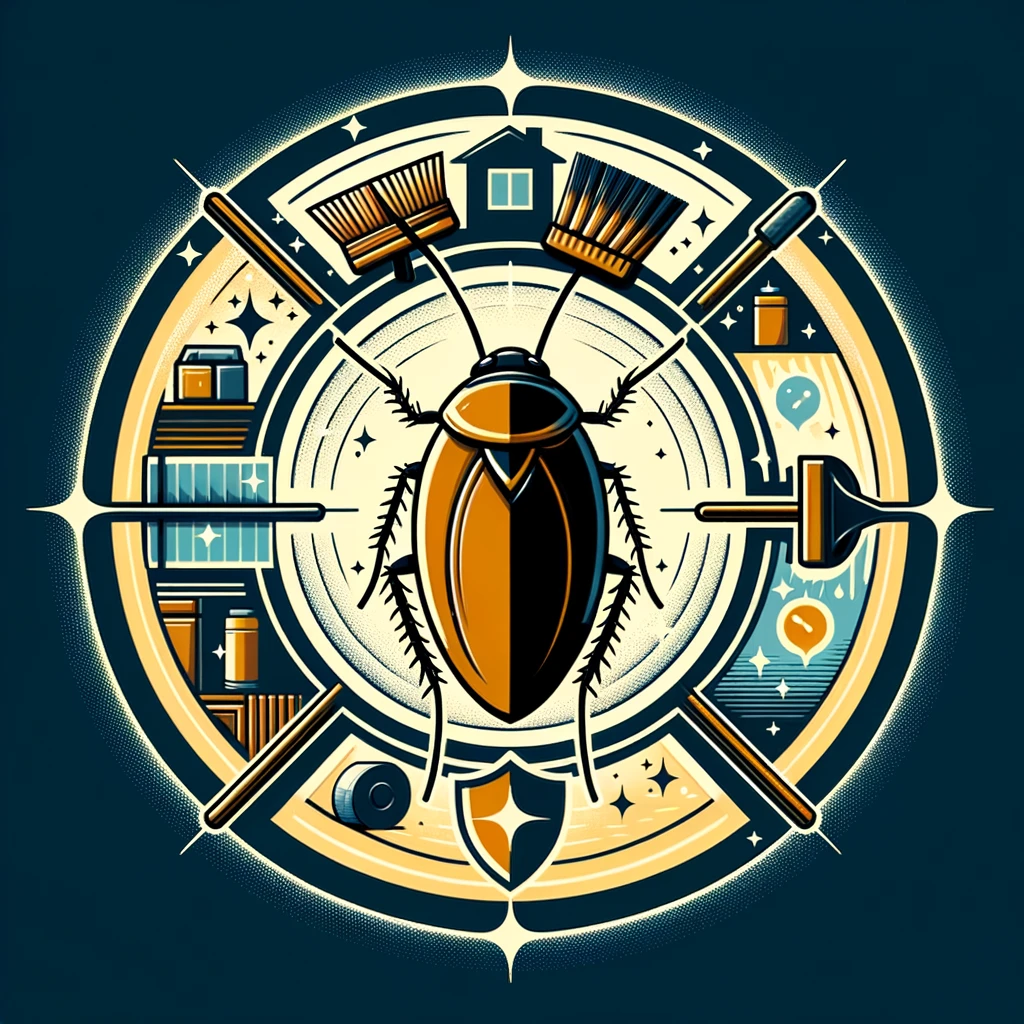 Discovering a heavy roach infestation in your home can be a distressing experience. Cockroaches are not only unwelcome guests but also potential carriers of diseases, making their eradication a top priority for homeowners. This comprehensive guide will walk you through effective strategies for how to get rid of a heavy roach infestation, combining immediate actions with long-term preventative measures to ensure your home becomes—and stays—roach-free.
Discovering a heavy roach infestation in your home can be a distressing experience. Cockroaches are not only unwelcome guests but also potential carriers of diseases, making their eradication a top priority for homeowners. This comprehensive guide will walk you through effective strategies for how to get rid of a heavy roach infestation, combining immediate actions with long-term preventative measures to ensure your home becomes—and stays—roach-free.
Understanding the Enemy
Before diving into eradication techniques, it’s crucial to understand what you’re dealing with. Cockroaches are highly resilient creatures with the ability to breed rapidly, making a heavy infestation particularly challenging to control. They thrive in environments that provide easy access to food, water, and shelter, making our homes ideal for their survival.
Immediate Steps to Take
1. Identify the Infestation Source
- Start by identifying where roaches are coming from. Look for entry points like cracks in walls, gaps around pipes, and other openings.
- Check areas that provide a water source, as roaches need water to survive. Fix leaky faucets and pipes.
2. Declutter and Clean Thoroughly
- Eliminate food sources by keeping your kitchen clean. Store food in airtight containers and avoid leaving dishes out overnight.
- Declutter your home to remove potential hiding spots. Pay special attention to dark, undisturbed areas where roaches may nest.
Professional Pest Control
For heavy infestations, professional pest control services are often necessary. These experts can provide a thorough assessment and apply industrial-strength treatments to areas you might not be able to reach.
Choosing the Right Pest Control Service
- Look for licensed, reputable professionals with experience in how to get rid of a heavy roach infestation.
- Ask about the methods and products they use, ensuring they’re safe for your family and pets.
DIY Treatment Options
While professional help is recommended for heavy infestations, there are DIY treatments that can support these efforts:
Baits and Traps
- Use baits and traps to reduce the roach population. Place them strategically around hotspots, checking and replacing them regularly.
Insecticides
- Insecticide sprays can be effective, but use them with caution. Choose products specifically designed for indoor use and follow the instructions carefully.
Long-Term Prevention Strategies
Eradicating a heavy roach infestation is only part of the solution. Implementing long-term prevention strategies is key to keeping them at bay:
Seal Entry Points
- Conduct regular inspections of your home’s exterior and interior, sealing any cracks and openings to prevent re-entry.
Maintain a Clean Environment
- Regular cleaning and maintenance are crucial. Vacuum frequently, dispose of garbage regularly, and keep your home free of food debris.
Monitor and Adjust
- Stay vigilant and monitor your home for signs of roach activity. Adjust your strategies as needed, and consider regular inspections by pest control professionals.
Conclusion: Restoring Peace of Mind
Dealing with a heavy roach infestation can be overwhelming, but with the right approach, it’s a battle you can win. Combining professional pest control services with diligent home maintenance and preventive measures will help you reclaim your home from these persistent pests. Remember, consistency is key to long-term success in keeping your living space healthy and roach-free.
Cockroach Bite Near the Eye
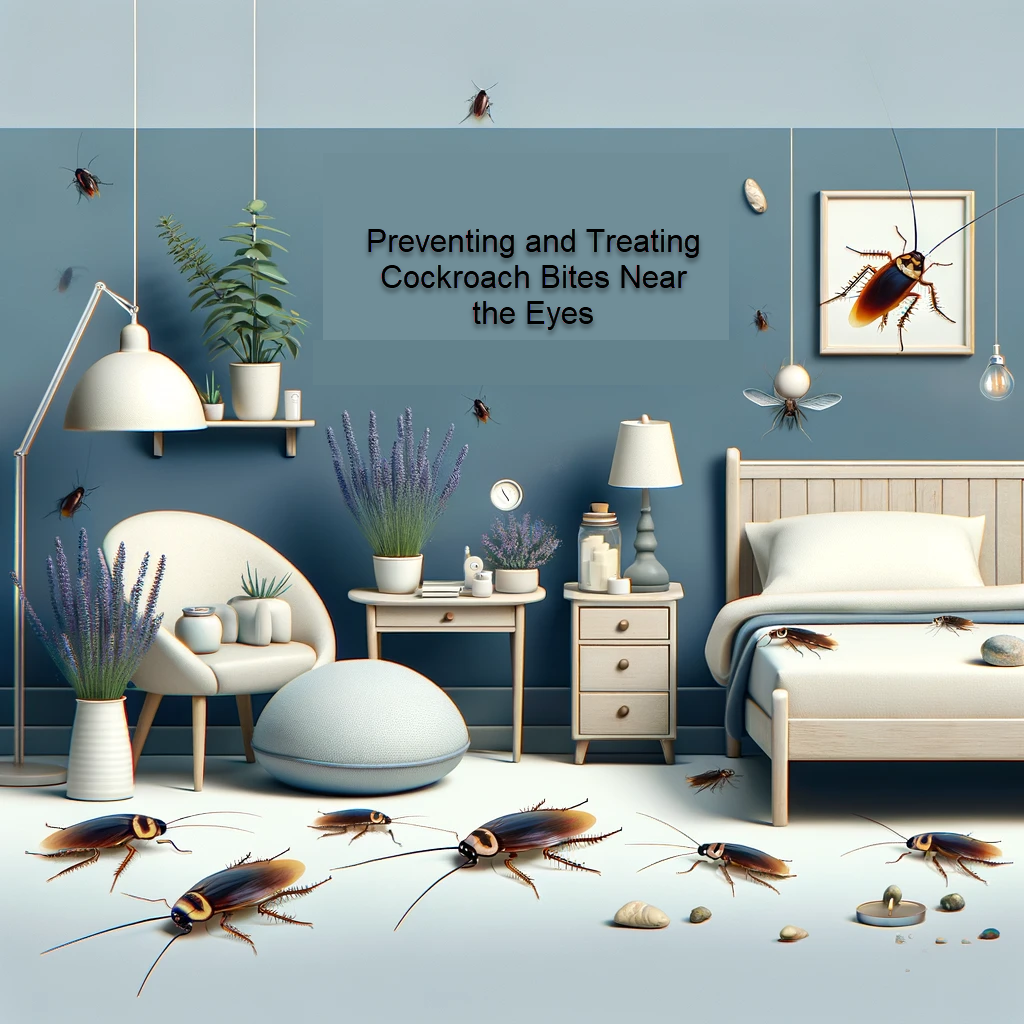 Understanding Risks and Prevention
Understanding Risks and Prevention
A nocturnal rustle, a sudden brush against your face, and the unthinkable happens—a cockroach comes into close contact with your eye. While the mere thought might send shivers down your spine, questions about the risks, treatments, and prevention of such an incident are valid and demand attention. This post dives into the reality of cockroach bites near the eye, offering insights into health implications, immediate steps for treatment, and strategies to prevent future encounters.
Understanding the Risks
Can Cockroaches Bite Your Eye?
First and foremost, it’s essential to clarify that cockroaches are not known to intentionally bite humans. However, in extremely rare cases, they might nibble on eyelashes, dead skin, or residues near the eyes if food sources are scarce. Such incidents are uncommon but can cause discomfort, irritation, or even infection due to bacteria cockroaches carry.
Health Implications and Symptoms of Cockroach Bite
- Infection Risk: Cockroaches can carry pathogens that might lead to infections if introduced to the eye area.
- Allergic Reactions: Some individuals may experience allergic reactions to cockroach saliva, exacerbating the irritation.
Cockroach Bites Treatment
If you suspect a cockroach has made contact with your eye or eyelid, taking prompt action can help mitigate risks:
- Rinse Your Eye: Gently wash the affected eye with clean, lukewarm water or saline solution to remove any debris or bacteria.
- Avoid Rubbing: Rubbing can cause further irritation or spread contaminants. Try to keep the eye closed and blink gently to promote natural tear production.
- Seek Medical Advice: If you experience persistent irritation, redness, or any vision changes, consult a healthcare professional immediately.
Prevention Tips for Cockroach Bite Near the Eye
Minimizing the chances of cockroach encounters, especially near sleeping areas, is key to avoiding such incidents:
- Maintain Cleanliness: Regularly vacuum and declutter to reduce cockroach hiding spots.
- Seal Entry Points: Inspect and seal cracks around windows, doors, and walls to prevent cockroach entry.
- Store Food Properly: Keep food in sealed containers and clean up crumbs and spills promptly.
- Use Natural Repellents: Essential oils like peppermint or lavender can deter cockroaches when applied around potential entry points.
Understanding Cockroach Behavior
Cockroaches are opportunistic feeders, drawn to human habitats in search of food and moisture. Their nocturnal nature and tendency to explore may lead them into close contact with humans, though such incidents are rare and not driven by aggression.
Conclusion: Safety and Vigilance
While the likelihood of a cockroach bite near the eye is low, understanding the potential risks and knowing how to respond is crucial for peace of mind. By adopting preventive measures and maintaining a clean, secure living environment, you can significantly reduce the chances of unwelcome cockroach encounters. Remember, knowledge and preparedness are your best tools in ensuring your nights remain undisturbed by pests.
Can Cockroaches Crawl in Your Ear When You Sleep?
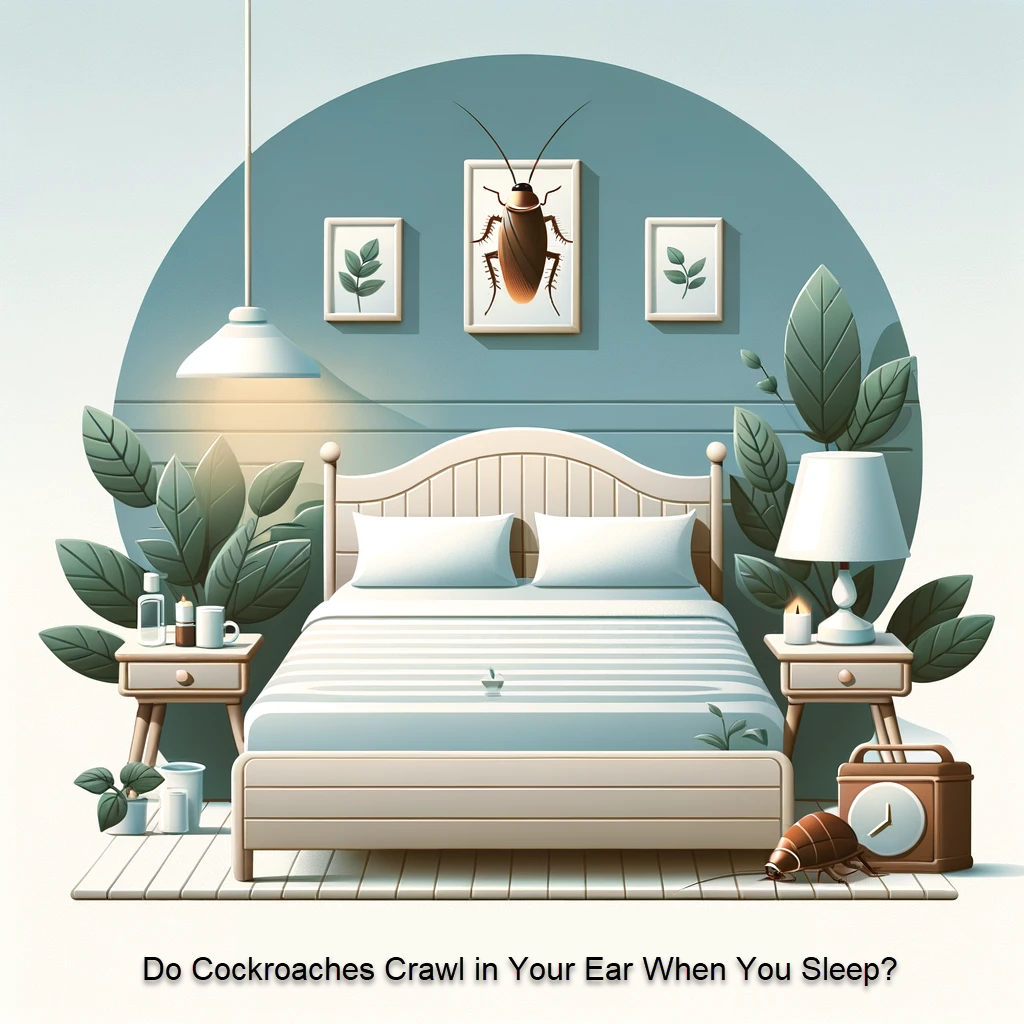 Debunking Myths and Ensuring Peaceful Nights
Debunking Myths and Ensuring Peaceful Nights
A common urban legend that often circulates, causing shivers down many spines, is the idea: can cockroaches crawl into your ear while you sleep. Such thoughts can turn peaceful nights into restless worry. But how much truth is there to this unsettling notion? This post aims to explore the realities behind this cockroach in ear – fear, debunk myths, and offer practical advice to ensure your sleep remains undisturbed by the thought of unwanted nocturnal visitors.
Understanding the Fear of Cockroach in Ear
The fear of cockroaches crawling into ears stems from the insects’ tendency to explore and squeeze into small spaces. While it’s not impossible for a cockroach to find its way into a human ear, such incidents are exceedingly rare. Understanding cockroach behavior helps put this fear into perspective.
Cockroach Behavior / Human Contact / Cockroach in Ear
- Nocturnal Activity: Cockroaches are primarily nocturnal and avoid light, which means they are more active at night. However, their nighttime activities are usually focused on searching for food and water, not exploring human ears.
- Attraction to Cracks and Crevices: Cockroaches are attracted to tight spaces for hiding and breeding, not human ears specifically. So can cockroaches crawl into your ear? The likelihood of a cockroach intentionally crawling into an ear is very low.
Debunking the Myth
Medical Reports and Statistics
- Rare Occurrences: While there have been isolated medical reports of cockroaches found in ears, these cases are extremely rare compared to the global population and frequency of cockroach-human encounters.
- Accidental Incidents: Most incidents of cockroaches entering ears are accidental and not a common behavior of the insects.
Preventive Measures
Ensuring that cockroaches are not attracted to your sleeping area can help alleviate fears and reduce the already minimal risk of such an encounter.
Maintain Cleanliness
- Reduce Food and Water Sources: Keep your sleeping area clean and free of food crumbs or water sources that might attract cockroaches.
- Regular Housekeeping: Vacuum and declutter regularly to minimize cockroach hiding spots.
Seal Entry Points
- Cracks and Gaps: Seal cracks in walls, windows, and doors to prevent cockroaches from entering your living spaces.
Use Natural Repellents
- Peppermint Oil: A natural deterrent for cockroaches, peppermint oil can be used around your bed and sleeping area to keep cockroaches at bay.
Conclusion: Rest Easy
While the thought of cockroaches crawling into ears during sleep can be disturbing, understanding the realities helps put this fear to rest. Such incidents are exceedingly rare, and simple preventive measures can further reduce the risk. By maintaining cleanliness, sealing entry points, and using natural repellents, you can ensure peaceful, worry-free nights. Remember, cockroaches are more afraid of you than you are of them, and they’re not out to disrupt your sleep.
What Smell Do Cockroaches Hate?
 Natural Repellents to Keep Them at Bay
Natural Repellents to Keep Them at Bay
Cockroaches are one of the most resilient and adaptable pests found in homes around the world. Known for their survival skills, these unwelcome guests often seem impervious to many control methods. However, like all creatures, they have their aversions. One particularly effective way to deter them involves leveraging their sense of smell. But what smell do cockroaches hate, and how can you use this knowledge to keep them at bay? This post explores natural repellents and how to incorporate them into your pest management strategy.
Understanding Cockroach Aversions
Cockroaches, with their highly developed olfactory receptors, are sensitive to a range of smells. This sensitivity can be turned against them, using certain scents to repel them from your living spaces. What smell do cockroaches hate? Here’s a look at some smells that cockroaches tend to avoid:
1. Peppermint Oil
Peppermint oil is renowned not just for its refreshing scent but also for its cockroach-repelling properties. Its strong, minty aroma is intolerable to cockroaches, making it an effective natural deterrent.
How to Use:
- Mix a few drops of peppermint oil with water in a spray bottle.
- Spray around potential entry points and common cockroach hideouts.
2. Citrus
Lemons and other citrus fruits have a natural acidity and scent that cockroaches dislike. While citrus alone may not eliminate an infestation, it can help keep areas cockroach-free.
How to Use:
- Add lemon juice or citrus oil to water and use it to clean surfaces.
- Place citrus peels in areas prone to cockroach activity.
3. Eucalyptus
Eucalyptus oil has a potent aroma that is unpleasant to cockroaches. Its use as a natural repellent can contribute to a cockroach-free environment.
How to Use:
- Mix eucalyptus oil with water in a spray bottle.
- Spray in closets, under sinks, and other dark, moist areas where cockroaches congregate.
4. Bay Leaves
Bay leaves, though a culinary delight for humans, act as a natural repellent for cockroaches. The smell of crushed bay leaves is particularly effective in keeping them away.
How to Use:
- Crush bay leaves and place them in areas of cockroach activity.
- Replace the leaves regularly to maintain their deterrent effect.
5. Cinnamon
Cinnamon’s strong, spicy scent is another aroma that cockroaches find off-putting. Using cinnamon can help deter cockroaches, though it may not kill them.
How to Use:
- Sprinkle cinnamon powder near entry points and in cockroach-frequented areas.
- Consider cinnamon oil as an alternative for spraying.
Conclusion: A Fragrant Defense
While the battle against cockroaches may seem daunting, incorporating scents they hate into your pest control strategy offers a natural and pleasant-smelling line of defense. What smell do cockroaches hate? From peppermint to cinnamon, these natural repellents can help keep your home cockroach-free without resorting to harsh chemicals. Remember, consistency is key, and these methods are most effective when used as part of a comprehensive pest management plan.
Understanding White Cockroaches
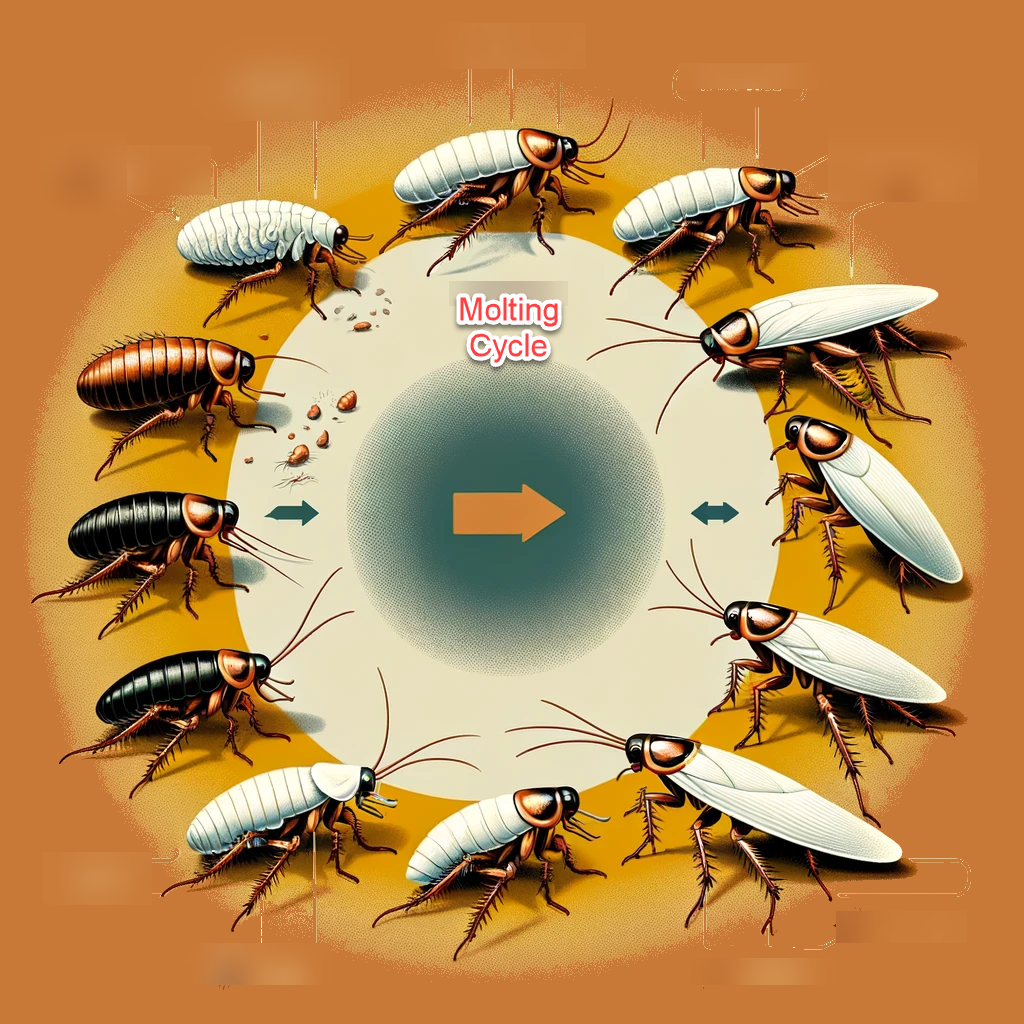 While cockroaches are commonly associated with dark, reddish-brown colors, sightings of white cockroaches can spark curiosity, concern, and a host of questions. White cockroaches are not a myth but rather a natural occurrence within the life cycle of these resilient creatures. This post explores the fascinating world of white cockroaches, shedding light on why they appear white, their significance, and what their presence means for your home.
While cockroaches are commonly associated with dark, reddish-brown colors, sightings of white cockroaches can spark curiosity, concern, and a host of questions. White cockroaches are not a myth but rather a natural occurrence within the life cycle of these resilient creatures. This post explores the fascinating world of white cockroaches, shedding light on why they appear white, their significance, and what their presence means for your home.
White Cockroaches – Mystery Solved
The Molting Process
- Natural Growth Cycle: White cockroaches are actually regular cockroaches in the midst of their molting process, during which they shed their old exoskeleton to grow. Immediately after molting, cockroaches appear white or pale because their new exoskeleton has not yet hardened or darkened.
- Temporary State: This white appearance is temporary. As the cockroach’s new exoskeleton oxidizes and hardens, it will gradually darken to its normal color.
These stages highlight the transformation a cockroach undergoes during the molting process, explaining the temporary white appearance as part of their natural growth cycle. (see image)
- Pre-Molt: The cockroach prepares for molting by absorbing water and swelling in size. During this stage, the old exoskeleton begins to separate from the underlying skin (cuticle).
- Molt Initiation: The cockroach starts shedding its old exoskeleton. This process can begin with the splitting of the exoskeleton along the back or head.
- Ecdysis (Molting): The actual shedding of the old exoskeleton occurs. The cockroach emerges with a soft and pale, often white, exoskeleton.
- Post-Molt (Teneral Stage): Immediately after molting, the cockroach appears white or very pale. This is because its new exoskeleton hasn’t yet hardened or gained pigment.
- Sclerotization (Hardening): The new exoskeleton gradually hardens and darkens to its normal color. This process involves the cross-linking of proteins in the cuticle, which strengthens and pigments the exoskeleton.
- Maturation: The cockroach fully matures into its new exoskeleton, regaining its typical coloration and the ability to resume normal activities, including feeding and locomotion.
Significance in Pest Control
- Indicators of Infestation: Frequent sightings of white cockroaches can indicate a high level of cockroach activity and breeding within your home, signaling the need for prompt pest control measures.
Addressing Common Questions
Are White Cockroaches Albino?
- Myth Clarification: Unlike the common belief, white cockroaches are not albino. Their white coloration is a temporary phase of their growth cycle, not a genetic condition.
Do White Cockroaches Pose Special Health Risks?
- Health Concerns: Like their darker counterparts, white cockroaches can carry pathogens and contribute to allergic reactions. The color of the cockroach does not affect the health risks associated with an infestation.
Pest Control Tips for White Cockroaches
While the approach to controlling white cockroaches doesn’t differ significantly from managing other cockroaches, understanding their life cycle can inform more effective pest control strategies.
Strategies for Control
- Regular Inspection: Monitor for signs of molting and increased cockroach activity, especially in warm, humid areas of your home.
- Sanitation and Prevention: Maintain cleanliness and reduce moisture to deter cockroach infestations.
- Professional Assistance: Consider seeking help from pest control professionals if you notice a persistent presence of white cockroaches, as it may indicate a larger infestation.
Conclusion
The appearance of white cockroaches in your home can be surprising, but understanding the molting process demystifies their presence. These temporary phases in a cockroach’s life highlight the importance of ongoing pest control and prevention strategies. By staying informed and proactive, homeowners can effectively manage cockroach populations, ensuring a healthier and pest-free living environment.
Red Cockroaches : Uncovering the Truth
 When we think of cockroaches, a specific image often comes to mind: those resilient, unwelcome house guests that seem to thrive in the face of adversity. However, the mention of “red cockroaches” adds a layer of mystery and intrigue to our understanding of these pervasive creatures. What exactly are red cockroaches? Are they a distinct species, a sign of a peculiar infestation, or merely a myth wrapped in a shell of misinformation?
When we think of cockroaches, a specific image often comes to mind: those resilient, unwelcome house guests that seem to thrive in the face of adversity. However, the mention of “red cockroaches” adds a layer of mystery and intrigue to our understanding of these pervasive creatures. What exactly are red cockroaches? Are they a distinct species, a sign of a peculiar infestation, or merely a myth wrapped in a shell of misinformation?
The color red often signals caution or danger in nature and human societies alike. So, it’s no surprise that the idea of a red cockroach could evoke a heightened sense of alarm or curiosity. Whether you’ve encountered what appears to be a red cockroach in your home, heard tales of their existence, or are simply fascinated by the world of entomology, you’re not alone in seeking answers.
This post aims to shed light on the truth behind red cockroaches. We’ll explore their identification, address common concerns about infestations, examine any unique health risks they may pose, and provide practical advice on managing these pests. By separating fact from fiction, we hope to demystify the concept of red cockroaches and arm you with knowledge to tackle any cockroach-related challenges with confidence.
Join us as we delve into the world of red cockroaches, uncovering the reality behind their colorful designation and what it means for homeowners and insect enthusiasts alike.
Identification: What Are Red Cockroaches?
The term “red cockroaches” might conjure images of brightly colored insects scurrying across your floor, but the reality is a bit more nuanced. In the vast world of entomology, cockroaches come in a range of colors, from the common brown and black to more unusual shades. While truly red cockroaches are rare, certain species exhibit reddish hues that might lead to their being described as “red.” Understanding these species is crucial in correctly identifying the cockroaches you might encounter.
Common Species with Reddish Hues
American Cockroach (Periplaneta americana): Often mistaken for being red, the American cockroach is actually more accurately described as reddish-brown. It is one of the largest species of common cockroaches found in homes and is known for its fast-moving nature. The nymphs (juveniles) of this species can also appear to have a deeper red color as they mature.
German Cockroach (Blattella germanica): Smaller than the American cockroach, the German cockroach’s nymphs have a darker color that might appear reddish under certain lighting conditions. As they grow, their color lightens to a more traditional tan or light brown, but the initial darker phase can lead to reports of “red cockroaches.”
Misidentification and Myths
It’s essential to note that lighting, environmental conditions, and the observer’s perception can all influence the perceived color of a cockroach. Additionally, myths and misinformation can lead to exaggerated descriptions of cockroach colors. True red cockroaches, in the sense of a vibrant, primary red color, do not commonly exist in nature.
The Importance of Accurate Identification
Accurately identifying the species of cockroach you’re dealing with is crucial for several reasons. Different species have different behaviors, habitats, and control strategies. For example, the American cockroach prefers damp areas and can often be found in basements and sewers, while the German cockroach is more likely to be found in kitchens and bathrooms. Knowing which species you’re dealing with helps tailor pest control efforts more effectively.
Infestation Concerns: Are Red Cockroaches Different?
The sighting of a cockroach, regardless of its color, can be a cause for alarm due to the potential health risks and the idea of an infestation. When it comes to cockroaches with a reddish hue, many wonder if these particular sightings should warrant additional concern. Here, we delve into whether red cockroaches differ from their more common counterparts in terms of infestation concerns.
Similarities Across Species
First and foremost, it’s important to understand that the basic behaviors and infestation patterns of cockroaches are more influenced by their species than their color. Whether a cockroach appears reddish-brown or another shade, its tendencies for seeking food, water, and shelter within human environments remain consistent. Thus, the fundamental concerns regarding cockroach infestations apply universally:
- Health Risks: All cockroaches, irrespective of color, can carry pathogens that may contaminate food and surfaces, leading to diseases.
- Allergies and Asthma: The presence of cockroaches can exacerbate allergies and asthma for some individuals, particularly through their droppings, shed skins, and saliva.
Unique Concerns
While the color of a cockroach might not significantly impact the nature of an infestation, certain species known for reddish hues, like the American cockroach, are larger and might be more intimidating to encounter. Additionally, the rapid reproduction rate of species such as the German cockroach means that even a few individuals can quickly lead to a larger infestation if not addressed.
Recognizing Signs of Infestation
Independent of color, recognizing the signs of a cockroach infestation is crucial for timely intervention. These signs include:
- Seeing Live or Dead Cockroaches: Spotting cockroaches during the day can indicate a large population, as they are typically nocturnal.
- Droppings: Small, pepper-like droppings near food sources or in corners can signal their presence.
- Egg Cases (Oothecae): Finding egg cases, which can contain numerous eggs, suggests a breeding population.
Proactive Measures
Understanding that the threat posed by cockroaches is not color-dependent emphasizes the importance of proactive pest control measures. Regular cleaning, sealing entry points, and proper food storage are critical steps in preventing infestations of any cockroach species.
Health Risks: Should You Be Worried?
The mere mention of cockroaches often conjures concerns about health risks, given their reputation for thriving in unsanitary conditions and potentially spreading diseases. When it comes to red cockroaches—or more accurately, cockroaches with reddish-brown hues—the question arises: do they pose any unique health risks compared to their counterparts? Let’s examine the health implications associated with cockroach infestations.
General Health Risks Posed by Cockroaches
Cockroaches, irrespective of their color, are known carriers of various pathogens, including bacteria, parasites, and viruses. These pests can contaminate food, cooking utensils, and surfaces with these pathogens, potentially leading to food poisoning, diarrhea, and other illnesses. Moreover, cockroaches are also linked to allergic reactions and asthma, particularly in sensitive individuals, due to the allergens found in their droppings, shed skins, and saliva.
No Color-Specific Risks
It’s important to clarify that there are no known health risks unique to cockroaches with a reddish hue. The color of a cockroach does not influence its ability to carry and spread pathogens. The primary concerns for human health stem from their behaviors—such as their feeding and nesting habits—rather than their physical appearance.
Preventing Health Issues
Preventing cockroach-related health risks involves a proactive approach to pest management and hygiene. Here are some key strategies:
- Maintain Cleanliness: Regularly clean floors, counters, and hidden spaces where cockroaches may find food remnants.
- Store Food Properly: Keep food in sealed containers to prevent contamination.
- Manage Waste: Dispose of garbage regularly and use sealed bins to deter cockroaches.
- Address Moisture: Fix leaky faucets and pipes and use dehumidifiers in damp areas to make your home less inviting to cockroaches.
Professional Assessment and Intervention
In cases of significant infestation, consulting with pest control professionals can provide a targeted approach to mitigating health risks. Professionals can assess the situation and recommend strategies to eliminate cockroaches and prevent future infestations effectively.
Pest Control: Managing Red Cockroaches
Discovering cockroaches in your home can be unsettling, regardless of their color. When it comes to managing cockroaches that appear reddish, understanding effective pest control strategies is key. Here, we explore how to manage and prevent infestations of these so-called “red cockroaches,” emphasizing that successful control measures apply broadly across various cockroach species.
Integrated Pest Management (IPM)
Integrated Pest Management (IPM) is a comprehensive approach that combines biological, cultural, physical, and chemical methods to manage pest populations effectively and sustainably. Applying IPM principles can help you address cockroach infestations in a manner that minimizes risks to human health, property, and the environment.
DIY Prevention and Control Tips
Effective cockroach management starts with prevention. Here are some DIY tips that can help keep your home cockroach-free:
- Seal Entry Points: Inspect your home for cracks and crevices, especially around doors, windows, and utility pipes, and seal them to prevent cockroach entry.
- Reduce Food Sources: Keep your kitchen clean, store food in airtight containers, and avoid leaving pet food out overnight.
- Eliminate Water Sources: Repair leaky pipes and faucets and eliminate standing water to reduce cockroach attraction.
- Declutter: Reduce clutter in your home to minimize hiding spots for cockroaches.
Chemical Controls
While non-chemical methods are preferred for their safety and sustainability, chemical controls can be necessary in cases of severe infestation:
- Baits: Cockroach baits can be effective in controlling populations by targeting the entire colony.
- Insecticides: Use insecticides as a last resort and choose products specifically designed for cockroach control. Always follow the manufacturer’s instructions to ensure safe use.
Professional Pest Control
When DIY methods are insufficient to control the infestation, it’s time to call in professional pest control services. Professionals can provide a comprehensive assessment and deploy a range of strategies tailored to your specific situation, ensuring the effective elimination of cockroaches from your home.
Understanding the Limitations
It’s important to recognize that managing cockroach infestations, especially in urban environments, can be challenging. Consistency in prevention and control efforts is key. Furthermore, while the focus here is on “red cockroaches,” the principles of cockroach management apply universally, regardless of the color or species of the cockroach.
Curiosity and Misinformation: Separating Fact from Fiction
In the digital age, where information is plentiful but not always accurate, myths about red cockroaches have proliferated, sparking unnecessary alarm and curiosity. It’s crucial to separate fact from fiction to approach the issue of cockroach control with clarity and effectiveness.
Debunking Myths About Red Cockroaches
Myth: Red cockroaches are a dangerous new species. Fact: There is no distinct species known as “red cockroaches.” The reddish-brown color observed in certain cockroaches, like the American cockroach, is typical of many species and does not indicate a new or more dangerous variety.
Myth: The color red in cockroaches signifies toxicity or aggression. Fact: The coloration of cockroaches has no correlation with toxicity or behavior. The perceived threat from cockroaches stems from their potential to spread pathogens and cause allergic reactions, not their color.
Myth: Red cockroaches are resistant to all forms of pest control. Fact: While some cockroach species have developed resistance to specific pesticides, this is not related to their color. Effective pest management requires a combination of strategies tailored to the specific species and situation.
Understanding the Role of Misinformation
Misinformation about red cockroaches can lead to unnecessary fear and the misuse of pest control methods. It’s important to rely on credible sources and professional advice when dealing with cockroach infestations. Educating yourself and others about the realities of cockroach behavior and control can help demystify these creatures and promote more effective, informed approaches to pest management.
Encouraging Responsible Pest Control
Recognizing the myths surrounding red cockroaches allows homeowners and residents to approach pest control more responsibly. Rather than resorting to drastic measures based on misinformation, it encourages the adoption of safe, sustainable practices that address the root causes of infestations.
Conclusion: Embracing Knowledge for Effective Cockroach Management
The journey through the world of red cockroaches has unveiled much about these misunderstood creatures and the myths that surround them. By separating fact from fiction, we’ve discovered that the key to managing cockroach infestations lies not in the color of these pests but in understanding their behaviors, habitats, and the effective strategies for their control.
Cockroaches, whether reddish-brown or any other hue, pose similar challenges and health risks in our homes. The myths surrounding red cockroaches serve as a reminder of the importance of basing our pest control efforts on scientific evidence and proven practices rather than rumors or misconceptions.
Effective cockroach management requires a multifaceted approach, incorporating cleanliness, habitat modification, and, when necessary, chemical interventions. Integrated Pest Management (IPM) stands out as a sustainable strategy that minimizes risks to humans and the environment, promoting a balanced coexistence with the natural world.
As we conclude, let’s remember that knowledge is our most powerful tool in the fight against cockroach infestations. By educating ourselves and others, we can dispel myths, reduce unnecessary fears, and adopt more effective, responsible pest control measures. Whether facing red cockroaches or any other pests, an informed approach is the key to creating healthier, pest-free environments for ourselves and future generations.
What do Dreams of Cockroaches Mean?
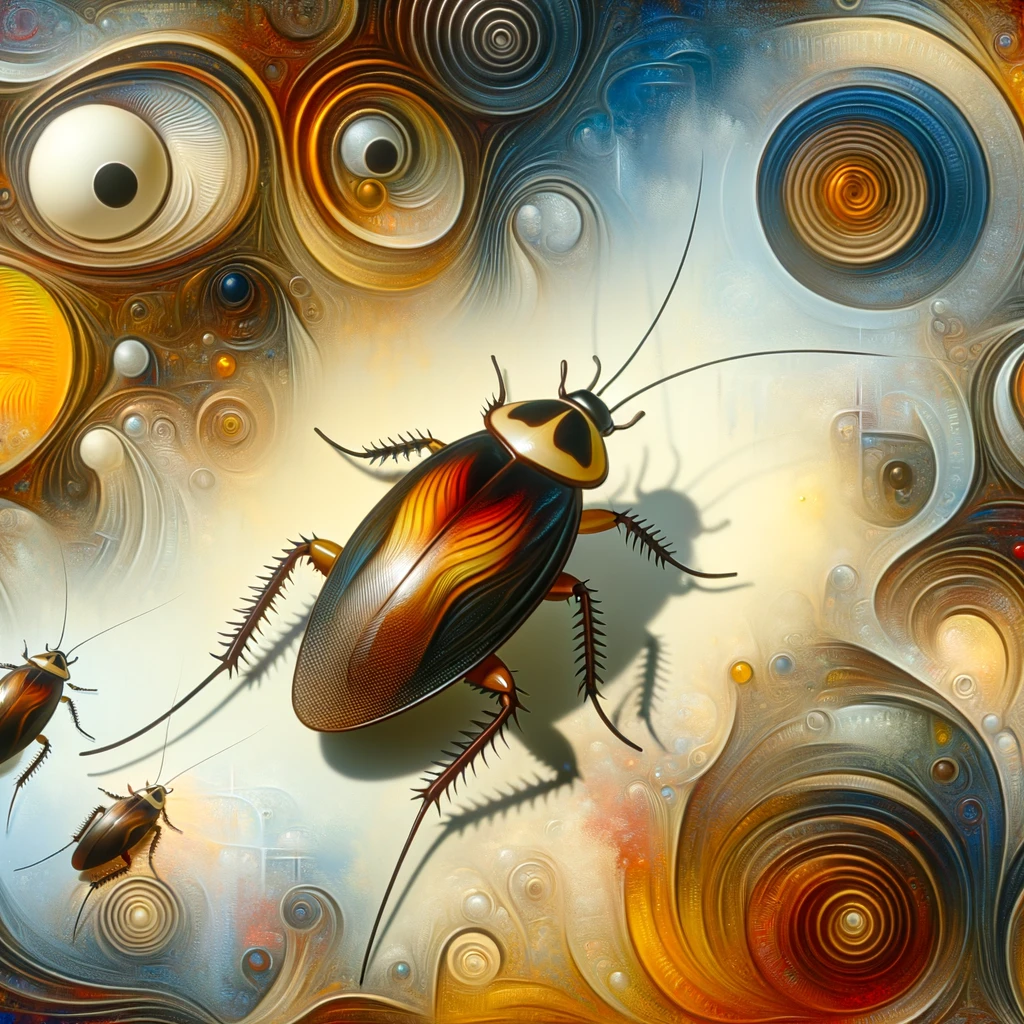 Dreams can be windows into our subconscious, often reflecting our deepest fears, desires, and unresolved issues. But what does it mean when these nocturnal narratives feature creatures as universally reviled as cockroaches? This post explores the various interpretations of dreams involving cockroaches, diving into psychological, cultural, and personal insights that these dreams might signify.
Dreams can be windows into our subconscious, often reflecting our deepest fears, desires, and unresolved issues. But what does it mean when these nocturnal narratives feature creatures as universally reviled as cockroaches? This post explores the various interpretations of dreams involving cockroaches, diving into psychological, cultural, and personal insights that these dreams might signify.
Psychological Interpretation
Symbol of Fear and Anxiety
Dreams of Cockroaches often symbolize underlying fears or anxieties in our waking life. These pests are typically associated with dirt and decay, so their presence in dreams could indicate worries about health, cleanliness, or a situation in your life that feels uncontrollable or “infested” with problems.
Representation of Resilience
Conversely, dreams of cockroaches can also highlight your resilience and ability to survive through difficult times. Just as cockroaches are known for their survival skills, your subconscious might be acknowledging your toughness in the face of adversity.
Cultural Significance
Varied Interpretations Across Cultures
Dreams of cockroaches meaning can vary significantly across different cultures. In some traditions, cockroaches are seen as omens of endurance and tenacity, while in others, they might represent an omen of upcoming renewal or a need for cleansing in one’s life.
Spiritual Meaning of Cockroaches
Some cultures might interpret cockroaches in dreams as spiritual messengers, prompting introspection or indicating the need to purge negative thoughts or behaviors. Understanding these cultural nuances can offer a richer perspective on your dream’s potential meanings.
Personal Insight
Reflections on Personal Hygiene or Health
Dreams of cockroaches can sometimes prompt a self-assessment of your physical or mental health. They might encourage you to examine your living conditions, personal hygiene, or to address neglected aspects of your health.
Unpacking Emotional Baggage
Such dreams might also symbolize the need to confront and cleanse emotional or psychological “clutter” that you’ve been carrying. This could be unresolved issues, guilt, or fears that need to be addressed for personal growth.
Conclusion: Embracing the Message
While dreams of cockroaches might initially evoke disgust or fear, they hold the potential for profound introspection and personal insight. By exploring the psychological, cultural, and personal significances of these dreams, you can uncover valuable messages from your subconscious. Remember, the key to understanding your dreams lies in reflecting on your current life situation, feelings, and experiences. Embrace these nocturnal narratives as opportunities for growth, healing, and self-discovery.
Do Spiders Eat Cockroaches?
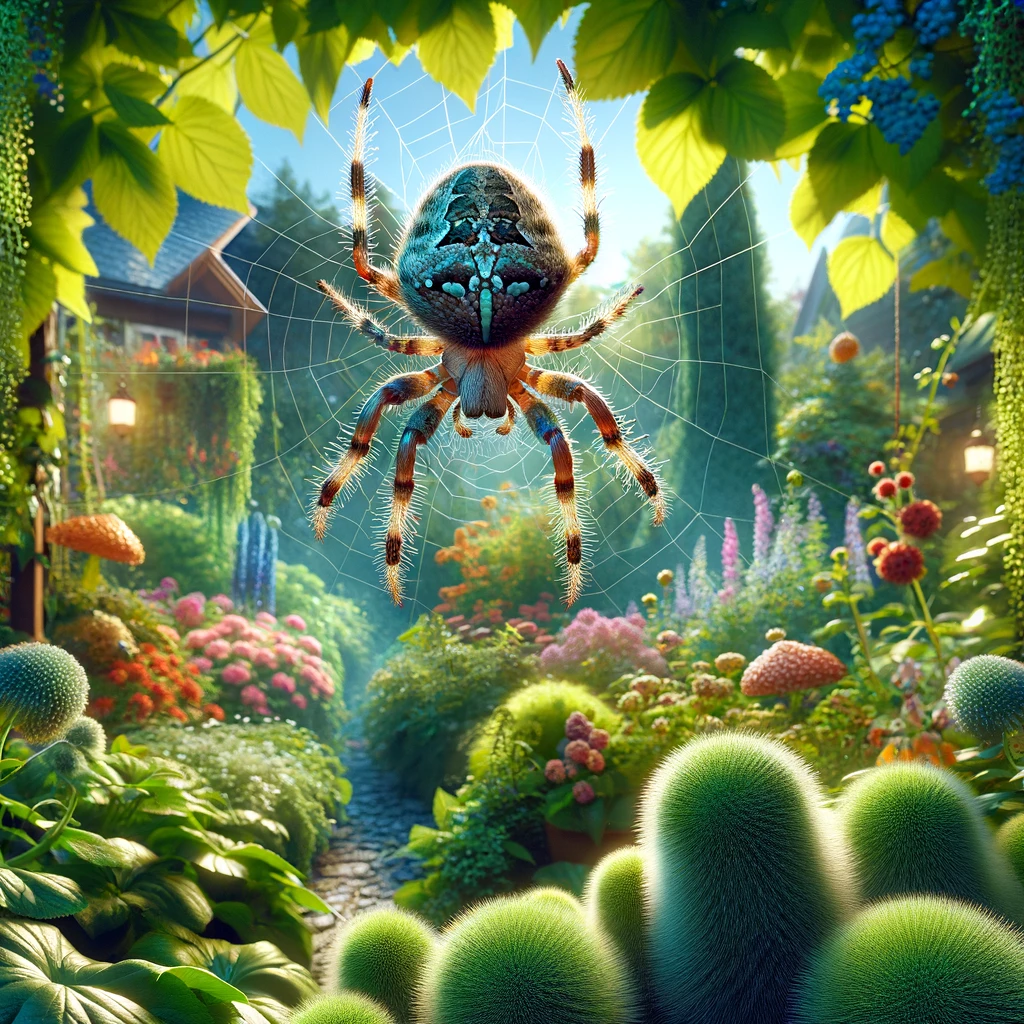 Unveiling Nature’s Pest Control
Unveiling Nature’s Pest Control
Welcome to the fascinating intersection of fear and curiosity—where the dread of cockroach infestations meets the enigmatic world of spiders. It’s a common scene in households worldwide: a sudden scurry of a cockroach vanishing into the shadows, leaving behind a trail of unease. Equally common, though less unsettling, is the sight of a spider, silently perched in its web or corner. This juxtaposition raises an intriguing question that has puzzled homeowners and nature enthusiasts alike: Do spiders eat cockroaches?
The answer weaves into the broader narrative of natural pest control, a topic gaining traction among those seeking eco-friendly alternatives to chemical repellents. Spiders, with their diverse diet and hunting strategies, emerge as potential allies in our ongoing battle against cockroaches. But how effective are these eight-legged arachnids in keeping cockroach populations at bay? And can understanding their dietary habits offer us insights into a more harmonious coexistence with the natural world?
Join us as we delve into the heart of this query, exploring the dietary preferences of spiders, identifying the species most likely to prey on cockroaches, and evaluating the practicality of relying on these arachnids as a form of pest control. Whether you’re grappling with a pest problem or simply fascinated by the intricate dance of predator and prey, this exploration sheds light on the unseen dynamics that play out in the corners of our homes and gardens.
The Diet of Spiders
Spiders are one of nature’s most efficient predators, not just because of their fascinating hunting methods, but also due to their varied diet that helps control the population of many insect species. But what exactly do these eight-legged hunters feast on?
A Diverse Palette
The diet of a spider is as diverse as the species itself. With over 45,000 species of spiders cataloged across the globe, their dietary habits can range from the highly specialized to the opportunistic. However, the core of a spider’s diet is made up of insects and other arthropods. This includes flies, mosquitoes, moths, beetles, and yes, even cockroaches.
Hunting Strategies
Spiders employ a variety of hunting strategies that are as diverse as their diet. Some, like the orb-weaver spiders, construct intricate webs to trap unsuspecting prey that flies into their sticky strands. Others, such as the wolf spider, forgo web-building altogether, opting instead for a more direct approach by hunting their prey on the ground.
Cannibalism and Beyond
Interestingly, spiders’ diets are not limited to insects alone. Cannibalism is not uncommon among spiders, especially when food is scarce or in densely populated areas. Some larger species may even prey on small mammals, birds, and fish, highlighting the adaptability and voracious appetite of these arachnids.
The Role of Spiders in Pest Control
Given their broad diet, spiders play a crucial role in controlling the populations of various pests, including those that are detrimental to human habitation and agriculture. Their presence in and around homes can significantly reduce the number of unwanted insects, including cockroach juveniles and adults, depending on the size and species of the spider.
Spiders That Prey on Cockroaches
While the idea of using spiders as a form of natural pest control against cockroaches might seem appealing, it’s essential to understand which spiders are up to the task. Not all spiders are interested in or capable of preying on cockroaches, but there are a few notable exceptions that do make these pests part of their diet.
Huntsman Spiders
Huntsman spiders are among the most effective predators of cockroaches. Known for their impressive size and speed, these spiders are capable hunters that can easily overpower a cockroach. Their preference for warm climates often brings them into close proximity with human dwellings, where they can be found hunting at night. Despite their somewhat intimidating appearance, huntsman spiders are generally harmless to humans and can significantly reduce cockroach populations.
Wolf Spiders
Wolf spiders, with their robust bodies and excellent hunting skills, are also known to feast on cockroaches. Unlike web-spinning spiders, wolf spiders chase down their prey, using their speed and agility to catch cockroaches on the ground. These spiders are solitary hunters and can often be seen roaming the floors and walls of homes in search of their next meal. Welcoming a wolf spider into your home means enlisting a tireless pest controller that works around the clock.
House Spiders
Common house spiders, while smaller than huntsman and wolf spiders, can also contribute to controlling cockroach populations. These spiders tend to build their webs in corners, under furniture, and in other out-of-the-way places where cockroaches might venture. While they may not take down adult cockroaches, house spiders can help manage juvenile cockroach populations, reducing future infestations.
The Natural Balance
It’s important to note that while these spiders can help control cockroach populations, they are not a silver bullet solution to a cockroach infestation. However, their presence in our homes is a testament to the delicate balance of nature’s ecosystem, where each species plays a role in controlling the populations of others. Encouraging the presence of these natural predators can be a part of an integrated pest management strategy that seeks to reduce reliance on chemical pesticides and promote biodiversity.
Effectiveness of Spiders in Controlling Cockroach Populations
While the idea of harnessing spiders as natural pest controllers is appealing, it’s crucial to assess the effectiveness of such an approach realistically. Spiders, indeed, prey on cockroaches, but several factors influence their impact on cockroach populations in our homes.
Factors Influencing Effectiveness
- Species and Size: The effectiveness of a spider in controlling cockroaches largely depends on its species and size. Larger spiders, such as huntsman spiders, are more capable of preying on adult cockroaches, while smaller spiders may only manage to catch smaller, juvenile cockroaches.
- Habitat and Hunting Grounds: The natural habitat and preferred hunting grounds of the spider also play a significant role. Spiders that hunt on the ground, like wolf spiders, are more likely to encounter and prey on cockroaches than those that dwell in webs placed in less frequented locations.
- Population Density: The impact of spiders on cockroach populations is also contingent upon their density in a given area. A solitary spider can only consume so many cockroaches, and unless there is a significant number of predatory spiders, their effect on an established cockroach infestation might be minimal.
The Reality of Pest Control
Spiders can contribute to controlling cockroach populations, but they are unlikely to eradicate an infestation entirely. Cockroaches are known for their resilience and rapid reproduction rates, which can outpace the predation pressure exerted by spiders. Additionally, the presence of spiders in significant numbers inside a home may not be desirable for everyone.
Integrating Spiders into Pest Control Strategies
Acknowledging the limitations of relying solely on spiders for cockroach control, it’s wise to view them as part of an integrated pest management (IPM) strategy. This approach combines physical, biological, and chemical methods to manage pest populations effectively and sustainably. Encouraging the presence of spiders can be one aspect of this strategy, complemented by:
- Sealing entry points to prevent cockroach access.
- Maintaining cleanliness to eliminate food sources.
- Using traps or baits to manage cockroach numbers.
Conclusion
While spiders are valuable allies in the fight against cockroaches, their effectiveness as standalone pest controllers is limited. Recognizing their role in the broader ecosystem and integrating them into a comprehensive pest management strategy can help manage cockroach populations more effectively, leading to a healthier home environment.
Benefits and Limitations of Using Spiders for Cockroach Control
Benefits
Natural Pest Control: Spiders are nature’s pest controllers. Their presence in and around homes can significantly reduce the populations of various household pests, including cockroaches, by naturally keeping their numbers in check.
Eco-Friendly: Utilizing spiders as part of pest control strategies minimizes the need for chemical pesticides, which can have harmful effects on the environment and human health. Spiders offer a more sustainable and environmentally friendly alternative.
Cost-Effective: Encouraging spiders to thrive in natural habitats around your home does not incur any costs, making it a cost-effective method for reducing pest populations.
Biodiversity: Spiders contribute to biodiversity, both as predators and as prey for other species. Their presence in an ecosystem is a sign of environmental health.
Limitations
Selective Predation: Spiders do not exclusively prey on cockroaches and will feed on a wide range of insects. Their presence alone may not sufficiently control cockroach populations, especially in the case of a severe infestation.
Fear and Misunderstanding: Many people have arachnophobia or a general unease around spiders. The idea of encouraging spiders as a form of pest control may not be appealing to everyone.
Indoor vs. Outdoor Effectiveness: While some spiders can thrive indoors and help control pests, many species are more effective in outdoor environments. The effectiveness of spiders in controlling indoor cockroach populations can vary.
Not a Standalone Solution: Relying solely on spiders for cockroach control is unlikely to be effective in eliminating an infestation. Integrated pest management approaches are necessary for comprehensive pest control.
Balancing the Benefits and Limitations
Understanding the benefits and limitations of using spiders as a form of natural pest control is crucial. While they play a significant role in managing pest populations, including cockroaches, spiders should be considered part of a broader, integrated pest management (IPM) strategy. This strategy might include maintaining cleanliness, sealing entry points, and, if necessary, using chemical controls judiciously.
Encouraging the presence of spiders around your home can be beneficial, but it’s essential to complement their natural predation with other pest control measures to effectively manage cockroach populations and ensure a comfortable living environment for all occupants.
Safe Pest Control Practices
Do spiders eat cockroaches? Yes, but while spiders play a natural role in controlling cockroach populations, relying solely on these arachnids isn’t enough to keep your home pest-free. Combining the benefits of spiders with other safe pest control practices can create a more effective and holistic approach. Here are some eco-friendly and safe strategies to manage and prevent cockroach infestations:
Maintain Cleanliness
- Eliminate Food Sources: Store food in sealed containers and avoid leaving dishes in the sink overnight. Regularly clean crumbs and spills from countertops, floors, and under appliances.
- Reduce Clutter: Clutter provides hiding spots for cockroaches. Regularly declutter your home, focusing on areas like basements, attics, and closets.
Seal Entry Points
- Cracks and Gaps: Inspect your home for cracks in walls, gaps around windows and doors, and holes where pipes enter. Use caulk or weatherstripping to seal these entry points.
- Ventilation: Ensure that vents are properly screened to prevent cockroach entry while maintaining good air circulation.
Use Natural Repellents
- Diatomaceous Earth: A non-toxic powder that can be sprinkled in areas where cockroaches are likely to enter or hide.
- Essential Oils: Some essential oils, like peppermint and lemongrass, have been reported to repel cockroaches. Use them in a diluted form as a spray around entry points and problem areas.
Encourage Natural Predators
- Outdoor Habitat: Create an outdoor environment that encourages spiders and other natural predators by maintaining a garden with a diversity of plants and minimizing the use of pesticides.
- Indoor Spiders: If you’re comfortable, allow non-venomous spiders to reside in less-frequented areas of your home, like basements and garages, where they can catch pests.
Professional Help
- Severe Infestations: For significant cockroach problems that persist despite your efforts, consider consulting a professional pest control service that uses eco-friendly methods.
Integrated Pest Management (IPM)
Adopting an IPM approach means using a combination of biological, cultural, physical, and chemical management tools in a way that minimizes economic, health, and environmental risks. Spiders are a part of this biological toolkit, working alongside your efforts to create a balanced, pest-resistant home environment.
Conclusion
Do spiders eat cockroaches? The intricate dance between predators and prey in our homes and gardens highlights nature’s delicate balance. Spiders, with their diverse diets and hunting strategies, play a crucial role in this ecosystem, including the control of pests like cockroaches. While the thought of using spiders as a natural form of pest control is intriguing, it’s clear that their effectiveness is influenced by various factors, including species, habitat, and the size of the pest population.
Understanding the benefits and limitations of relying on spiders for cockroach control is key. They can be valuable allies in reducing pest numbers, but they are not a standalone solution to infestations. Integrating spiders into a broader pest management strategy that includes cleanliness, sealing entry points, using natural repellents, and, when necessary, seeking professional help, offers a more comprehensive approach to keeping our homes pest-free.
Encouraging the presence of spiders and adopting safe pest control practices not only minimizes our reliance on chemical treatments but also supports biodiversity and ecological health. As we navigate the challenges of pest management, let’s remember the role of natural predators and the importance of creating balanced environments that benefit both humans and the planet.
In the end, the question “Do spiders eat cockroaches?” opens the door to a deeper understanding of nature’s complexities and the opportunities for sustainable living within our own homes. By embracing eco-friendly pest control methods and recognizing the value of all creatures in the ecosystem, we can foster healthier, more harmonious spaces for ourselves and future generations.
- How Long Can a Cockroach Live Without Air?
- The Lifecycle of the German Cockroach: From Egg to Adult
- Do Mice Eat Roaches
- Wood Roach vs. Cockroach
- Cockroach Poop: A Telltale Sign of Infestation
- Are Roaches Cannibals?
- Cockroach in Your Fridge
- Do Cats Eat Cockroaches?
- Nature’s Pest Control: What Eats Cockroaches?
- The Big Black Cockroach: Your Comprehensive Identification and Control Guide
- Do Roaches Bite? Uncovering the Truth and Prevention Strategies
- Hissing Cockroaches: Masters of Sound Among the Roach Kingdom
- Do Cockroaches Sleep? Unraveling the Mysteries of Cockroach Behavior
- Cockroach Life Cycle: Insights for Effective Pest Control
- Oriental Cockroaches: Identification, Infestation, and Control
- What are Sewer Roaches? How to Get Rid of Them
- Flying Cockroach: Identification and Control
- Cockroach Mouth Parts, Structure, and Functions: A Closer Look
- American Roaches vs. German Roaches
- Cockroach Poop vs. Mouse Poop
- How to Get Rid of a Heavy Roach Infestation
- Cockroach Bite Near the Eye
- Can Cockroaches Crawl in Your Ear When You Sleep?
- What Smell Do Cockroaches Hate?
- Understanding White Cockroaches